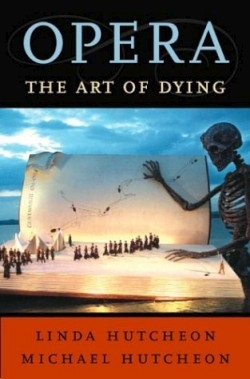Opera
The Art of Dying
This book examines Western thoughts on mortality through the development of opera, from the art’s birth at a time of religious zeal, through its growth during the age of reason, to the present, when belief in the afterlife has eroded, replaced by faith in science and technology.
The book begins with a discussion of Dialogues des Carmelites (Dialogues of the Carmelites), composed by Francois Poulenc in 1957, based on a true story set in Paris 1794 during the Reign of Terror. It focuses on a novice with an obsessive fear of death, who enters a convent hoping to avoid execution. The authors say that Poulenc took up this opera to help him deal with the death of a close friend. It was based on a play by his contemporary, Georges Bernanos, who wrote it as a tale of individual psychological and spiritual development dealing with an obsessive fear of dying, while he was dying of cancer.
Death in the past was part of normal home life in the West. Today, because people expect science to fight death to the last, normal death occurs as far away from the living as possible. To the modern mind, people in the times before medical miracles seemed to simply accept death because they were powerless against it. The authors show that each age had different responses to mortality. Death became increasingly secularized over the last centuries; the positive understanding of death in Western thought saw its crux in German Romanticism. It is in this discussion that this volume shines. In their previous book, Opera: Desire, Disease, Death the authors (Linda is a critical theorist; her husband, Michael, is a physician) began their examination of the topic, focusing on the great Italian operas whose characters suffer death due to physical illness. This book discusses characters who die because of emotional, societal, and philosophical reasons.
In the chapter “Eros and Thanatos,” an examination of Richard Wagner’s Tristan and Isolde, the authors comment on how the philosopher Arthur Schopenauer’s writings influenced Wagner: “With death the individual (who exists only as phenomenon) is joyfully dissolved back into the noumenal oneness. Because the difficulty of life lies specifically in individuation, death is the only release from the pain of individual existence.” The Hutcheons write, “For Schopenauer, the non-existence after death was like birth before and being in either one was not to be mourned.”
The authors contend that Wagner goes beyond pure Schopenauer in his storytelling; the composer “believed sexual love was a way to transcend the phenomenal world that was equal in its power to Schopenauer’s more ascetic solution of simply renouncing the will to live.” In the opera’s second act, the lovers sing repeatedly: “Without naming / without separating” (“Ohne nenne / Ohne trenne”) to express their desire to merge identities. Wagner combines the German romantic obsession with “Liebestod” or “love-death.” When Schopenauer said he could not understand the suicide of lovers, Wagner wrote a letter in response explaining that the will to live could be pacified through erotic love.
The book explores suicide in opera not through the stories of star-crossed lovers but through culture-crossed ones. In Giaccomo Puccini’s Madama Butterfly and two other operas, non-European heroines sacrifice themselves to allow their European lovers to return to society. The main characters in both Alban Berg’s Wozzeck and Benjamin Britten’s Peter Grimes are also seen as disruptions to society and are pressured into committing suicide.
In a chapter on the undead, the authors examine Der Kaiser von Atlantis (The Emperor of Atlantis), written by Viktor Ullmann and Peter Kien from inside a concentration camp in 1943. Of the original cast members of this opera, only one survived the Holocaust. This chapter also looks at Heinrich Marcher’s Der Vampyr and how it influenced Wagner’s Flying Dutchman. Death is simply closure of a life too separated from living. “The positive view of death is perhaps most clear in the case of the undead in opera,” explain the authors. “Here death is seen as release, as reunion, as the desired end. Death is, quite simply, what gives meaning to life.”
The only way the book falters is in that the authors stop twenty years too soon in developing their hypothesis. They connect the birth of the late medieval ars moriendi (“art of dying”) with the birth of opera, contending that since the art developed in the context of famine, wars, plagues, it matured with a tradition of meditating on death. However, the modern audience has gone through a further change. Members of Generation X have been so overexposed to artifice that they do not project themselves into presentations as generations before did. For modern audiences, it is reality as art that inspires contemplation of life, and this volume offers much to contemplate.
Reviewed by
Michelle Moore
Disclosure: This article is not an endorsement, but a review. The publisher of this book provided free copies of the book to have their book reviewed by a professional reviewer. No fee was paid by the publisher for this review. Foreword Reviews only recommends books that we love. Foreword Magazine, Inc. is disclosing this in accordance with the Federal Trade Commission’s 16 CFR, Part 255.

